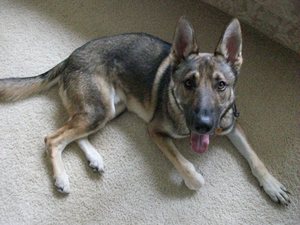No one is a fan of a dog with a dry, brittle coat. The dog is less pleasant to pet, and doesn’t look his best. Diet plays a huge role in coat health; what you feed your dog can directly contribute to that shiny, healthy coat your dog deserves. But with so many dog food options out there, it’s tough to figure out which is the best choice. The two main components of skin and coat health are fatty acids and key vitamins. By breaking down the specific ingredients that contribute to a healthy coat, dog owners can make the best decisions when buying their dog’s food.
How do fatty acids help skin condition?
Fatty acids are vital to your dog’s healthy coat and skin in two ways.
Sebum – The oily-ness associated with hair is called sebum. It’s a substance produced by the sebaceous gland in every hair follicle. Sebum helps coat the skin and keep it hydrated, reducing drying and flaking. The more omega-3 in the sebum, the more shiny and soft your dog’s coat will be.
Anti-inflammatory – Omega-3 has been shown to have anti-inflammatory properties. Often, inflammation can cause your dog’s skin to become dry and irritated, leading to scratching and sores. Omega-3 can help reduce reclamation and heal dermatitis.
Where do fatty acids come from?
One source of fatty acids is a high quality animal protein. Fish such as salmon or tuna have the highest amounts of omega-3 and -6. Other animal products may include chicken fat or eggs. Some plant oils are very high in fatty acids, and include canola oil, sunflower oil, and flax. You may see one or all of these ingredients in your dog food.
What about vitamins?
There are several vitamins that play a key role in skin health for your dog. Vitamins help the body process other dietary components such as minerals and amino acids. Vitamin B12 specifically helps your dog’s body break down proteins and fats into their usable parts. Vitamin D is essential for absorbing calcium and phosphorus. You may see some of these vitamins listed by their names on your dog food label, or they may be under a different name. For instance, vitamin B5 is often called calcium pantothenate or pantothetic acid in the ingredient list.
What to look for in your dog food
So how do you know if your dog food has the proper ingredients for coat health? First, look at the protein source in your food. It should be the main ingredient. It could be fish, fowl, or lamb, but it should be whole and not “meal”. Second, check for other ingredients such as flax or plant oils. Third, familiarize yourself with some of the key vitamins for skin health and their “alternative” names. This combination of protein, oils and vitamins will go a long way to keep your dog’s coat and skin healthy and shiny.
Sources:
Two ways Omega-3s Help Your Dog’s Skin and Coat
Dog Nutrition for a Healthy Coat WebMD Pets
More Pet Nutrition Articles
Nutritional Tips for Senior Dogs
Importance of Fiber in Your Dog’s Diet
Healthy Teeth for Dogs: Vitamins and Minerals



